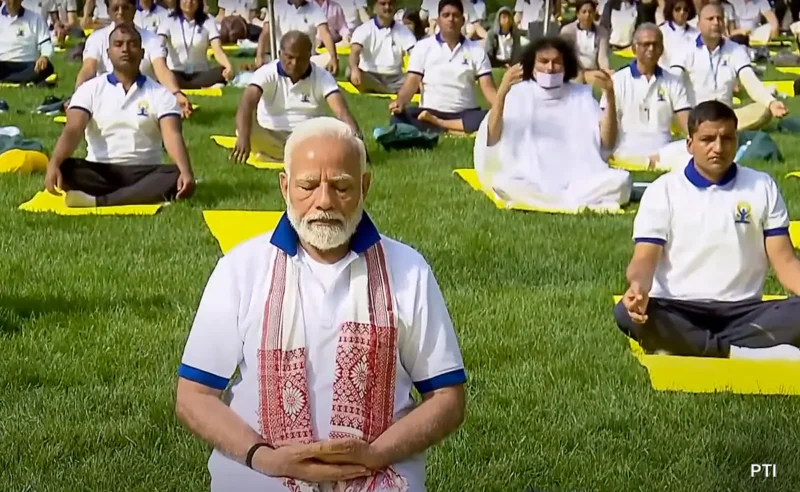Every year on 21st June, the world celebrates International Yoga Day, a landmark initiative proposed by Prime Minister Narendra Modi at the United Nations in 2014. With 177 nations co-sponsoring the resolution, it set a record—echoing a global desire for inner peace and holistic well-being.
Today, Yoga is practiced across 195 countries, taught in Ivy League universities, prescribed in medical clinics, and embedded in modern wellness tourism. It is no longer a niche Indian practice but a global phenomenon.

“Yoga is not just about exercise. It is a way to discover the sense of oneness with yourself, the world and nature.” – PM Modi
🧭 Losing the Soul of Yoga in Its Homeland?
Paradoxically, as the world turns to India for authentic yoga, India itself seems to be inching away from its spiritual roots in favor of a commodified, diluted version. The spirit of Yoga, grounded in discipline (Tapas), mindfulness (Smriti), and detachment (Vairagya), is now competing with Instagram trends, power yoga chains, and selfie-centric workshops.
⚠ Alarming Trends in India
1. Commercialisation over Contemplation
Yoga studios mushrooming in malls offer “weight loss yoga,” “pre-wedding yoga,” and “hot yoga,” reducing this sacred tradition to a fitness fad rather than a path to moksha (liberation).
2. Erasure of Philosophy
Very few yoga courses or studios in urban India teach Patanjali’s Yoga Sutras, the Bhagavad Gita, or Hatha Yoga Pradipika. Students know Asanas but not the Eight Limbs (Ashtanga Yoga).
3. Declining Interest Among Youth
According to a survey by the AYUSH Ministry, only 18% of Indian urban youth aged 18–30 practice yoga regularly. The percentage is higher in some parts of Europe.
4. Tokenism in Institutions
In many schools and government offices, International Yoga Day is reduced to a one-day photo-op, devoid of continuity, understanding, or inner transformation.
Yoga: A Way of Life, Not an Event
Yoga in its original essence is a 24-hour lifestyle rooted in Yama (moral restraints) and Niyama (observances)—truthfulness, non-violence, contentment, austerity, and devotion. It is meant to be lived, not just performed.
Case Example: The Village vs. the Metropolis
In a tribal village in Odisha, elders still teach children to begin the day with Surya Namaskar, followed by silent prayer and deep breathing near rivers. Here, Yoga is embedded in life, untouched by modern distractions.
Compare that with a high-end Delhi yoga class where teenagers attend to “stretch” before clubbing, and teachers seldom mention pranayama or dhyana.
Reviving the Spirit of Yoga in India
1. Reintegrate Yoga Philosophy in Education: NCERT & AYUSH must ensure spiritual and ethical dimensions of Yoga are reintroduced from school level.
2. Community-Based Yoga Therapy: Yoga should be offered in Primary Health Centres (PHCs) to treat lifestyle disorders, mental stress, and addiction.
3. Guru-Shishya Revival: Encourage authentic mentorship under trained Acharyas, rather than weekend workshops.
4. Regional Language Yoga Literature: Make Sanskrit-rooted yoga accessible in Hindi, Tamil, Bengali, and regional tongues.
Conclusion: From India to the World, But Not Without India
Yoga is India’s civilisational gift to the world, but if we lose its soul at home, we risk becoming mere exporters of form without substance. International Yoga Day should serve as a reminder—not just to stretch our bodies—but to stretch our consciousness.
Let us not just celebrate Yoga. Let us live it.
